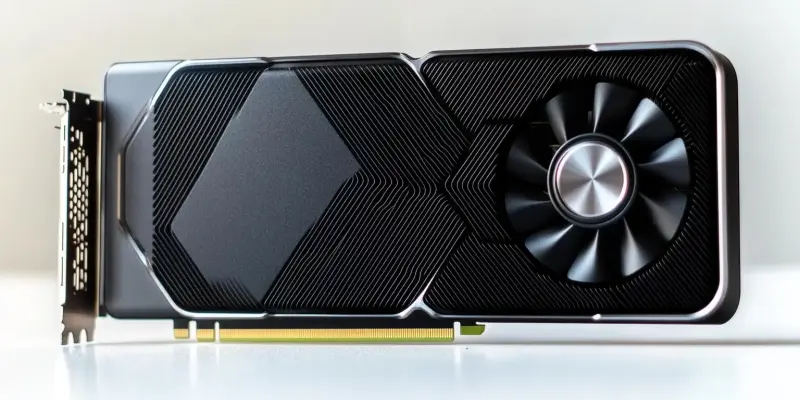In a recent leak that has stirred excitement within the tech community, Gainward’s NVIDIA GeForce RTX 5080 GPUs have been unveiled, revealing groundbreaking details about their specifications and forthcoming market release. These high-performance graphics cards are set to push the boundaries of what is currently possible in both gaming and professional computing applications, promising substantial improvements over their predecessors. The GeForce RTX 5080 has been confirmed to feature an impressive 16 GB of GDDR7 memory, a sign of its powerful capabilities. With the GPUs already packaged and prepared for shipment, anticipation is high for their official debut.
Technical Specifications
Core Architecture and GPU Die
At the heart of the GeForce RTX 5080 is the full GB203 GPU die, a marvel of modern engineering. This die is equipped with 84 Streaming Multiprocessors (SMs) and houses a staggering 10,752 cores. This configuration translates to a 51% reduction in core count when compared to the RTX 5090, yet it still represents a significant leap in performance from previous generations. The increased number of cores is expected to enhance parallel processing capabilities, crucial for handling the complex computations demanded by contemporary applications.
Additionally, the GeForce RTX 5080 utilizes the PG144/147-SKU45 PCB, a detail that underscores the architectural advancements present in this new lineup. The PCB design is optimized for efficiency, ensuring that the GPU can deliver peak performance with minimal thermal and energy overheads. The integration of advanced cooling solutions and power management systems will support gamers and professionals alike in their quests for uncompromised performance.
Memory Configuration and Speed
One of the standout features of the RTX 5080 is its 16 GB of GDDR7 memory, operating across a 256-bit bus interface. This configuration offers an impressive memory bandwidth, reaching speeds of up to 32 Gbps and providing a total bandwidth of 1024 GB/s. This tremendous speed is indicative of the card’s potential in handling extremely data-intensive tasks, from ultra-high-resolution gaming to complex simulation workloads.
The move to GDDR7 memory reflects a broader trend in the GPU industry towards faster and more efficient memory technologies. These advancements are critical for applications that demand rapid data access and manipulation, ensuring smooth, lag-free performance. For end-users, this means a more responsive and immersive experience, whether they are immersed in a virtual world or conducting intricate scientific research.
Performance and Power Requirements
Expected Performance Gains
The performance improvements offered by the RTX 5080 are substantial, owing to its advanced core architecture and memory configuration. Gamers can look forward to higher frame rates, reduced latency, and support for next-generation gaming technologies like ray tracing and advanced AI-driven enhancements. These features promise to deliver a level of visual fidelity and realism that pushes the boundaries of what is currently achievable in the gaming industry.
In professional applications, the RTX 5080 is poised to enhance workflows in fields such as video editing, 3D rendering, and machine learning. The increased core count and memory bandwidth will enable quicker data processing and more detailed simulations, driving efficiencies and fostering innovation. This versatility makes the RTX 5080 a compelling option for a broad range of users, from casual gamers to professional content creators.
Power Consumption and Thermal Design
With a total board power (TBP) of 360W, the RTX 5080 marks a 12.5% increase in power consumption compared to its predecessor. This increase is a reflection of the card’s enhanced capabilities and the need for sufficient power to drive its high-performance components. As such, users will need to ensure that their systems are adequately equipped with power supplies and cooling solutions to support the RTX 5080’s demands.
The emphasis on power efficiency and thermal management cannot be understated. Advanced cooling technologies, such as vapor chambers and high-efficiency fans, are expected to be integral components of the RTX 5080’s design. These solutions will help maintain optimal operating temperatures, preventing thermal throttling and ensuring sustained performance even under heavy loads. For users, this translates to reliable and unwavering performance, regardless of the intensity of their computing tasks.
Market Position and Future Implications
Anticipated Launch and Product Lineup
The RTX 5080’s release is aligned with the broader launch schedule for NVIDIA’s latest GPU lineup, with expectations set for late January or early February. This lineup includes other exciting models like the RTX 5090, 5070 Ti, 5070, 5060 Ti, and 5060. Each of these models will feature varied GPU cores, memory capacities, and power requirements, catering to a diverse range of performance needs and budgets.
The strategic positioning of these GPUs highlights NVIDIA’s commitment to advancing graphical performance and setting new industry standards. By offering a spectrum of options, from flagship models to more accessible versions, NVIDIA aims to capture a wide market share and cater to both high-end enthusiasts and everyday users. This inclusive approach is likely to drive widespread adoption and reinforce NVIDIA’s leadership in the GPU market.
Implications for the Future
A recent leak has sparked considerable excitement in the tech community with the unveiling of Gainward’s NVIDIA GeForce RTX 5080 GPUs. This revelation has provided groundbreaking insights into their specifications and upcoming market release. Designed to push the boundaries of current technology, these high-performance graphics cards are poised to revolutionize both gaming and professional computing applications. They are expected to deliver significant enhancements over their predecessors. The GeForce RTX 5080 is confirmed to boast an impressive 16 GB of GDDR7 memory, highlighting its formidable capabilities. Unlike previous models, this advancement in memory type will likely offer faster processing and better overall performance. With these GPUs already packaged and ready for shipment, the anticipation for their official launch is palpable. Enthusiasts and professionals alike are eagerly awaiting the opportunity to see firsthand what these cutting-edge cards can achieve. The breakthrough promises to elevate the standards for what is possible in the realms of gaming and computing.

